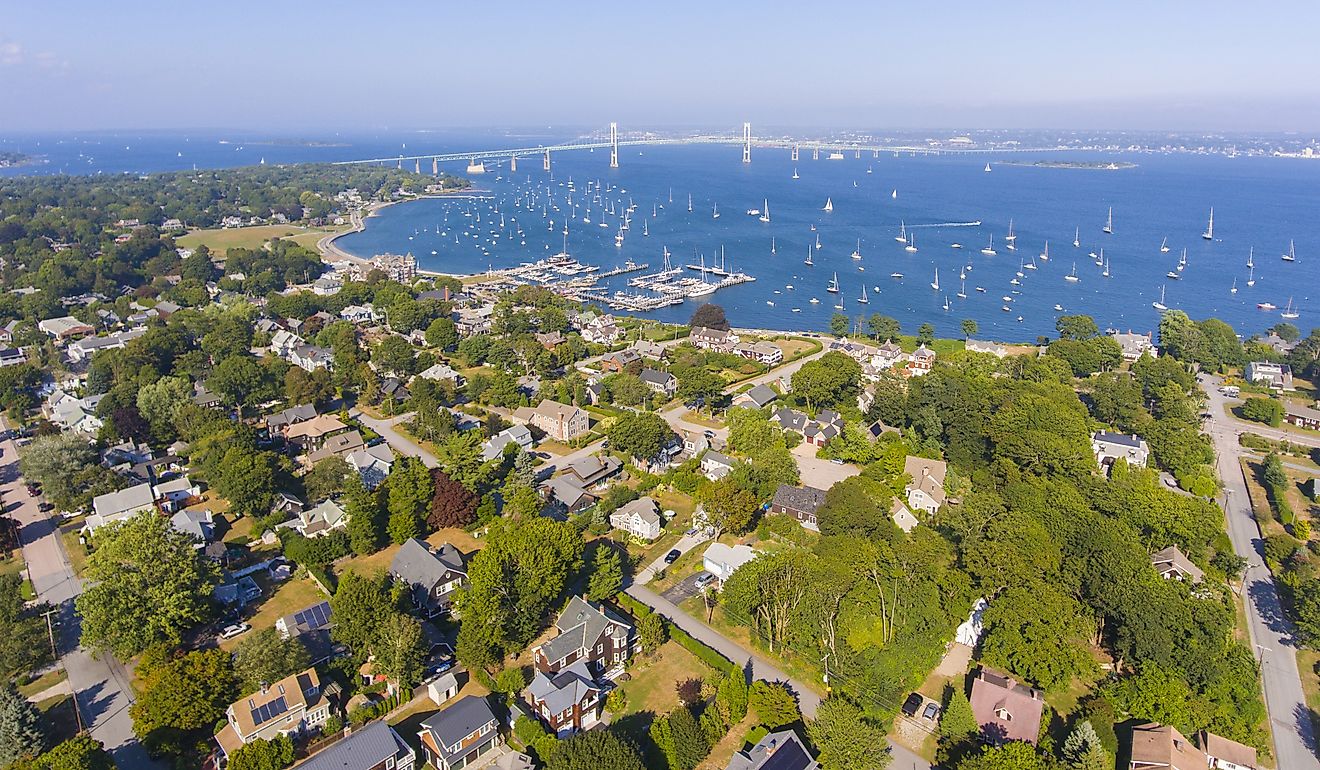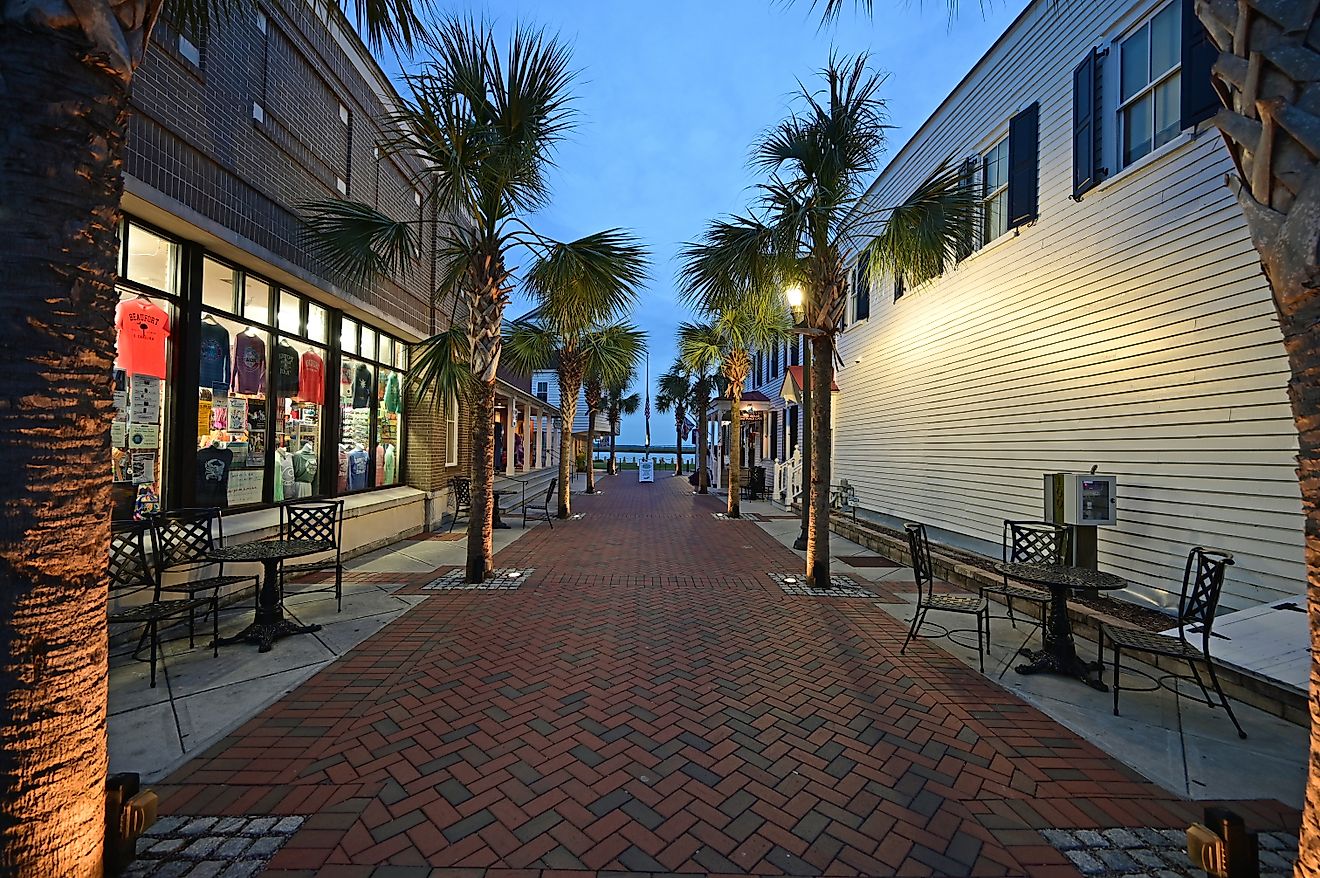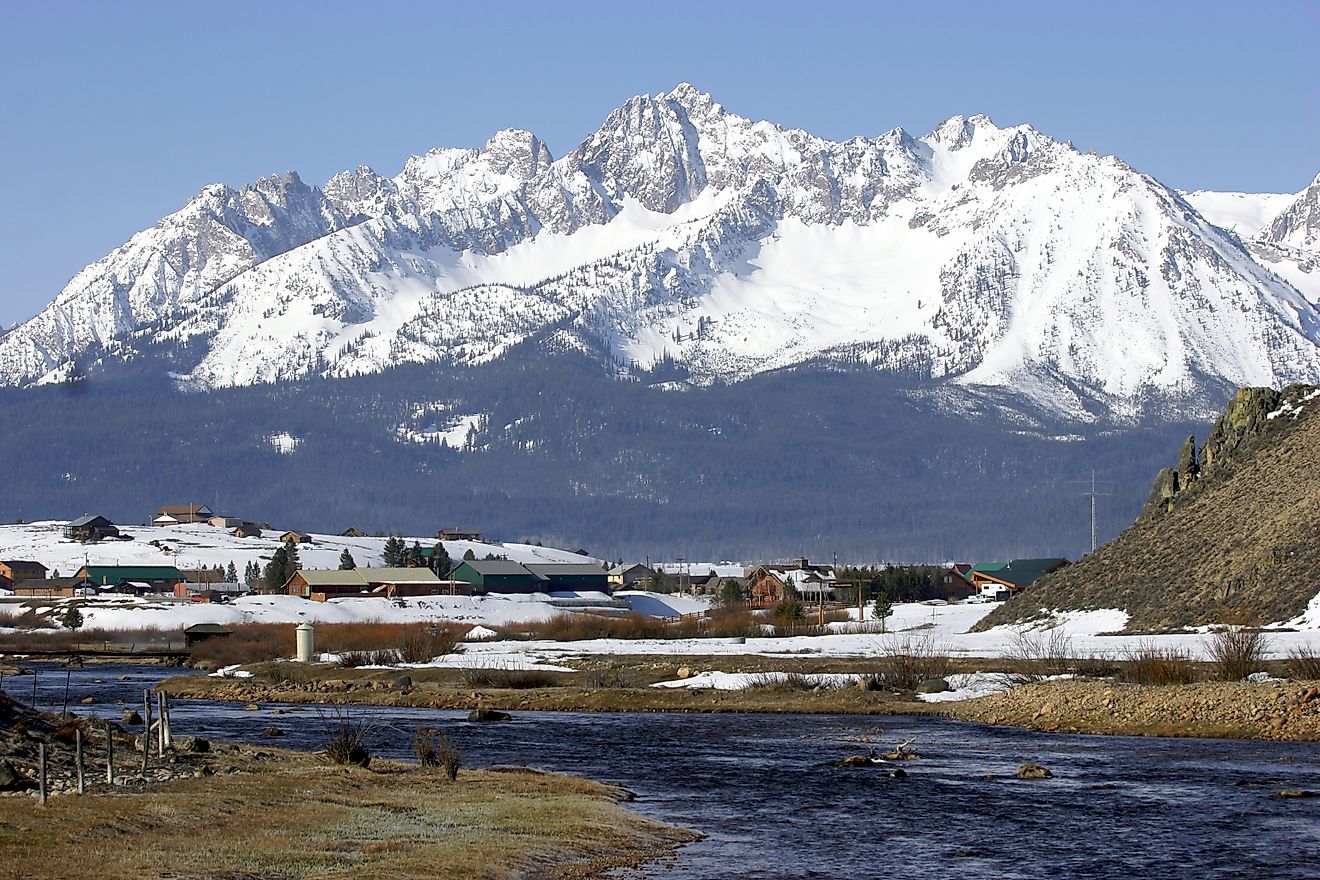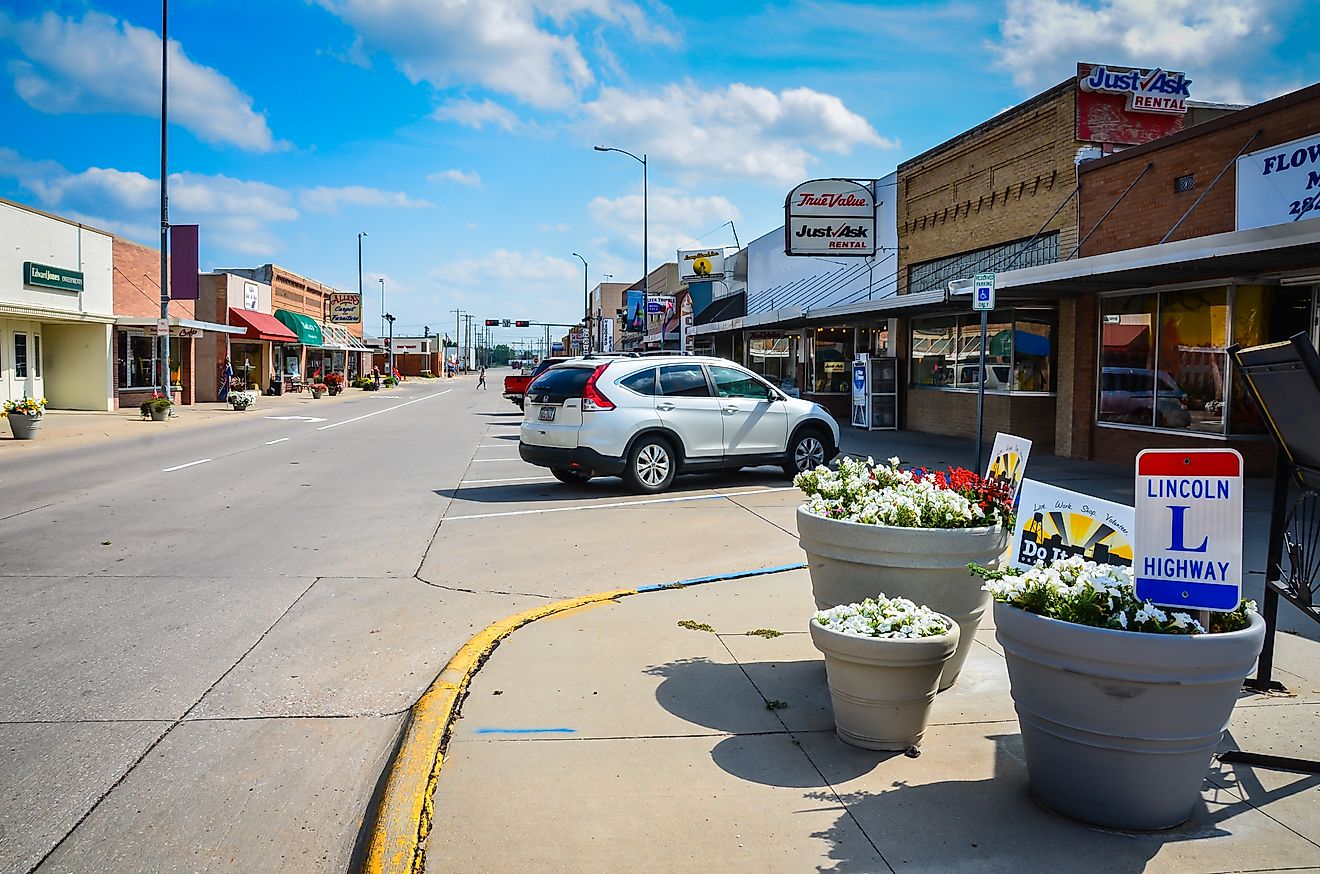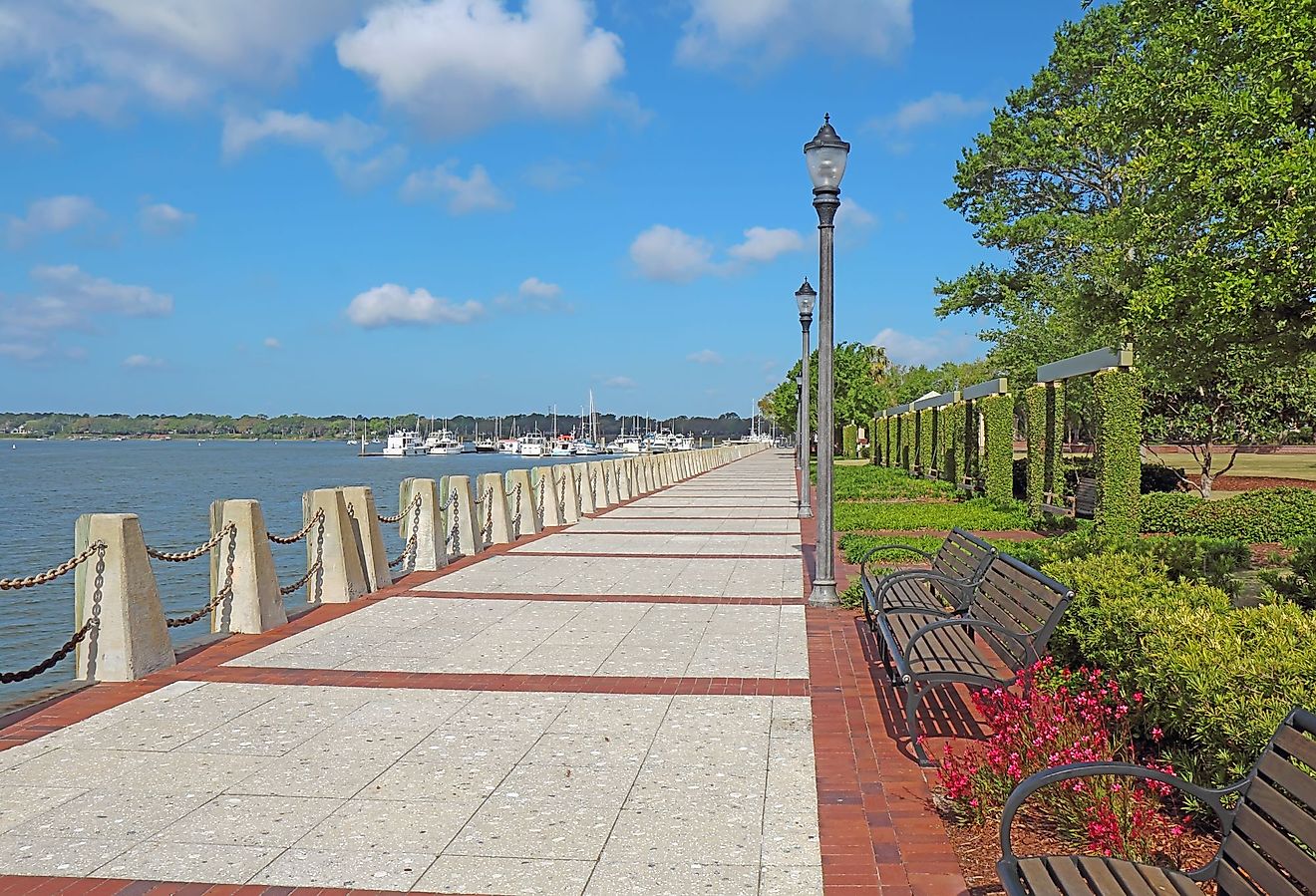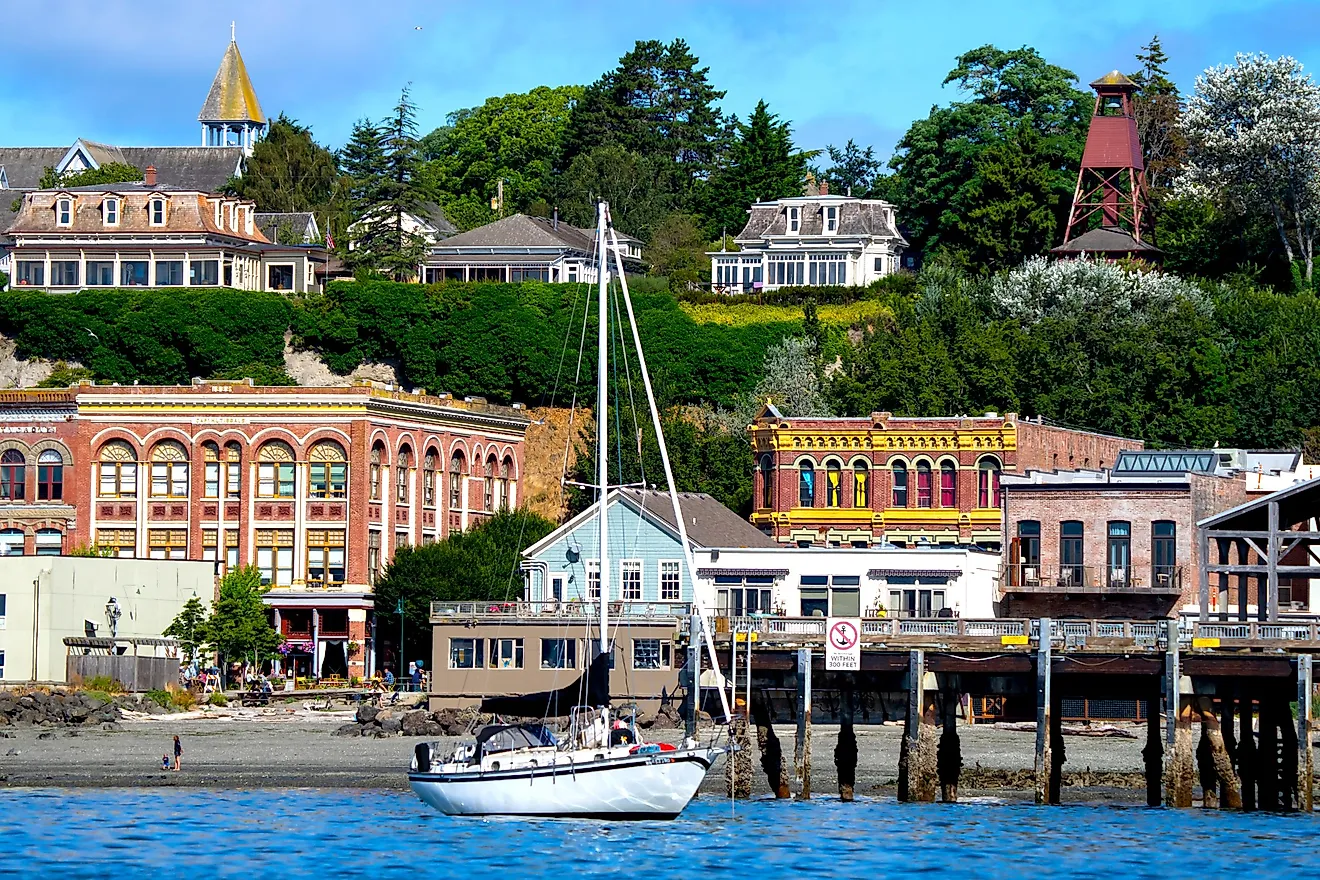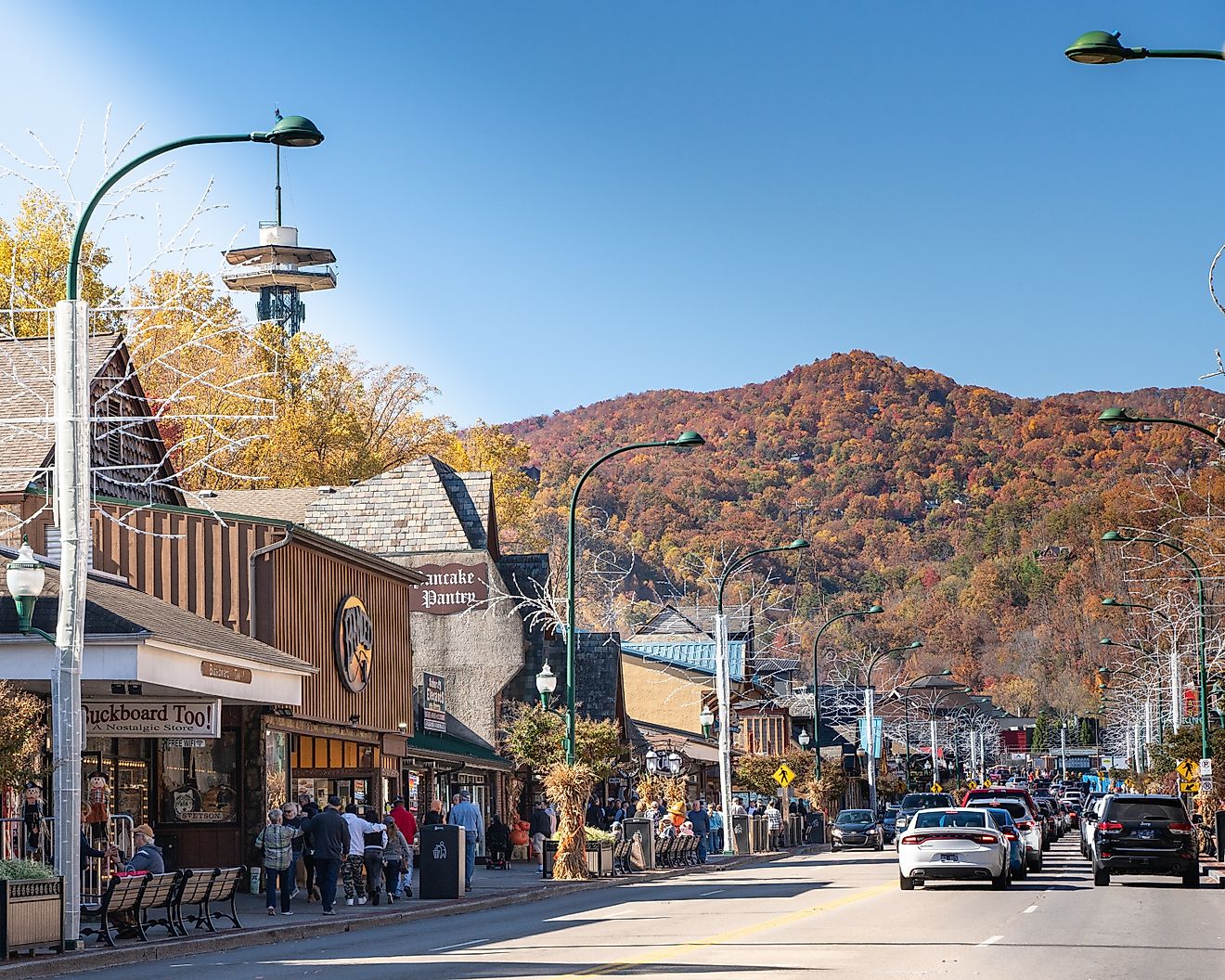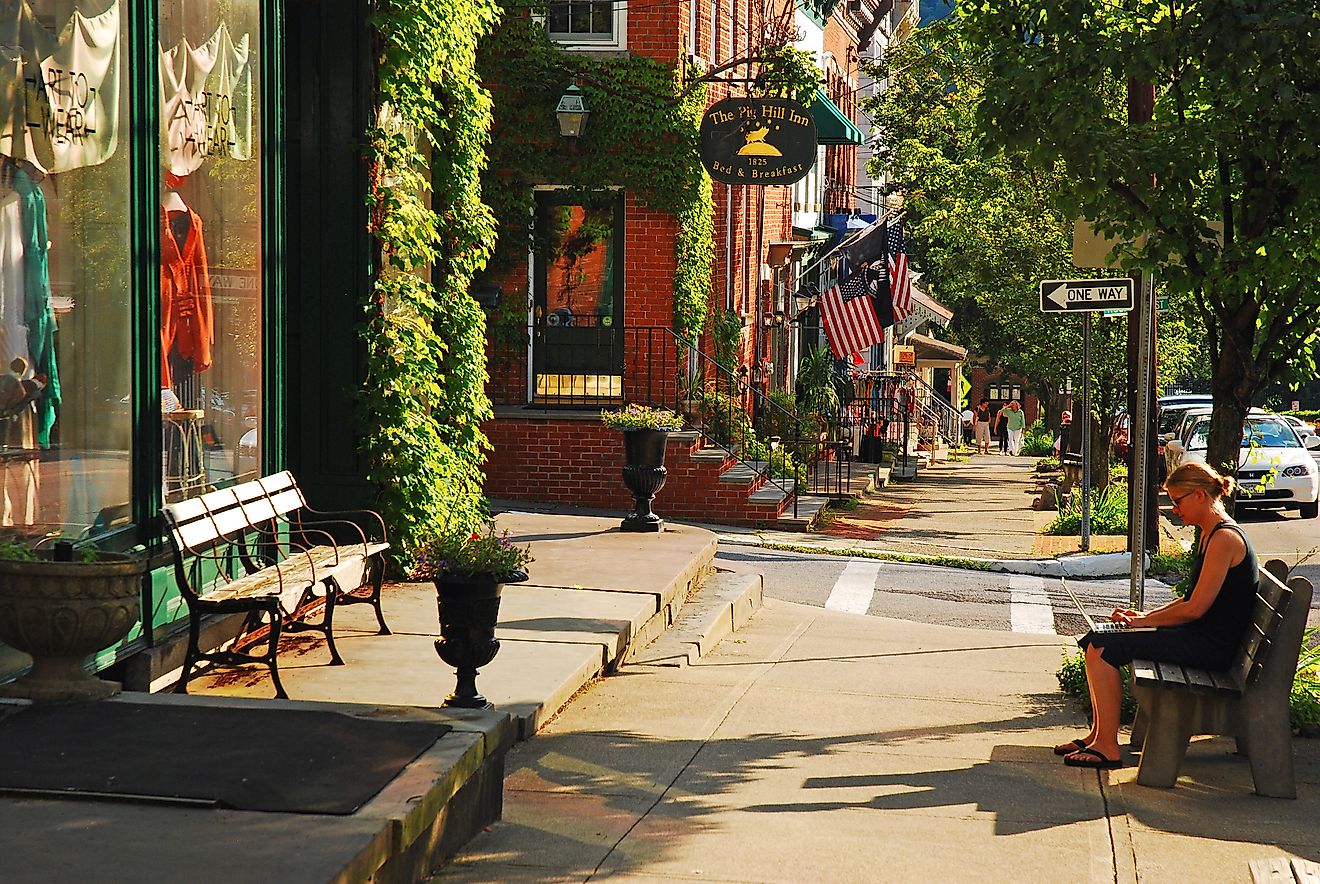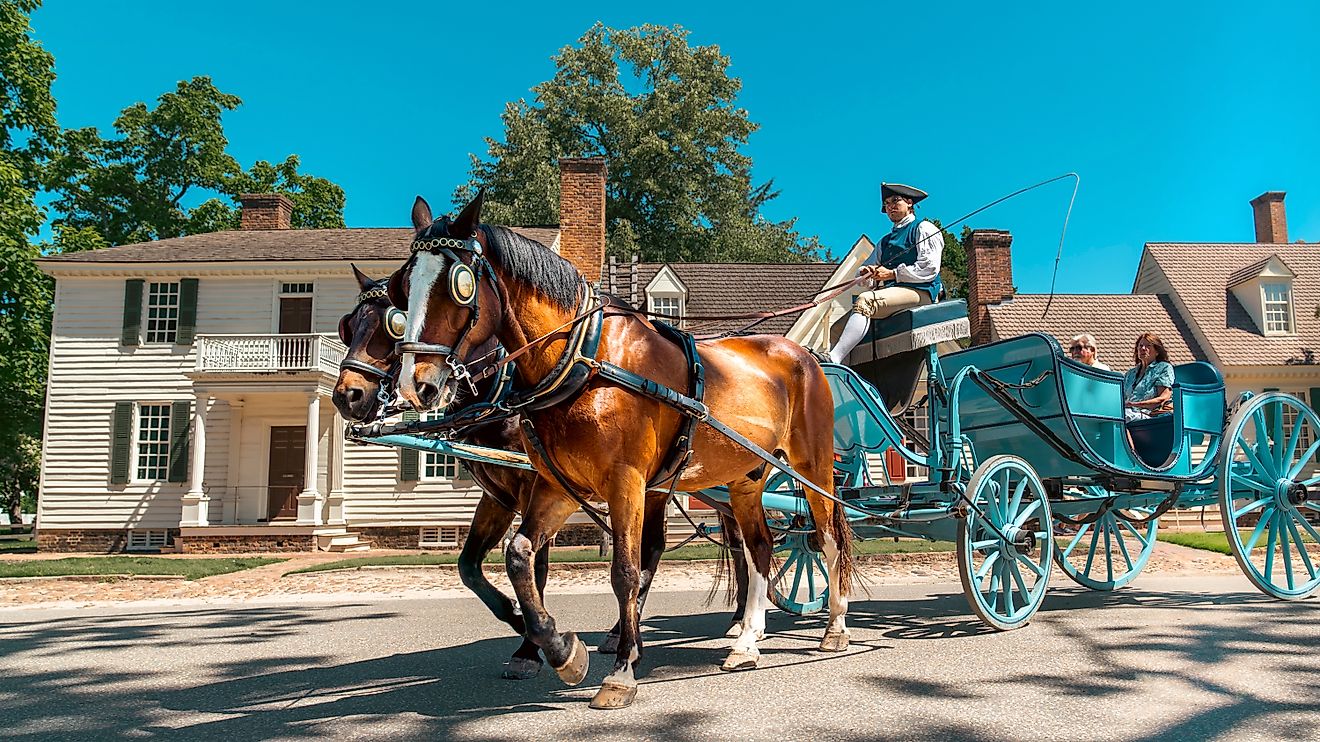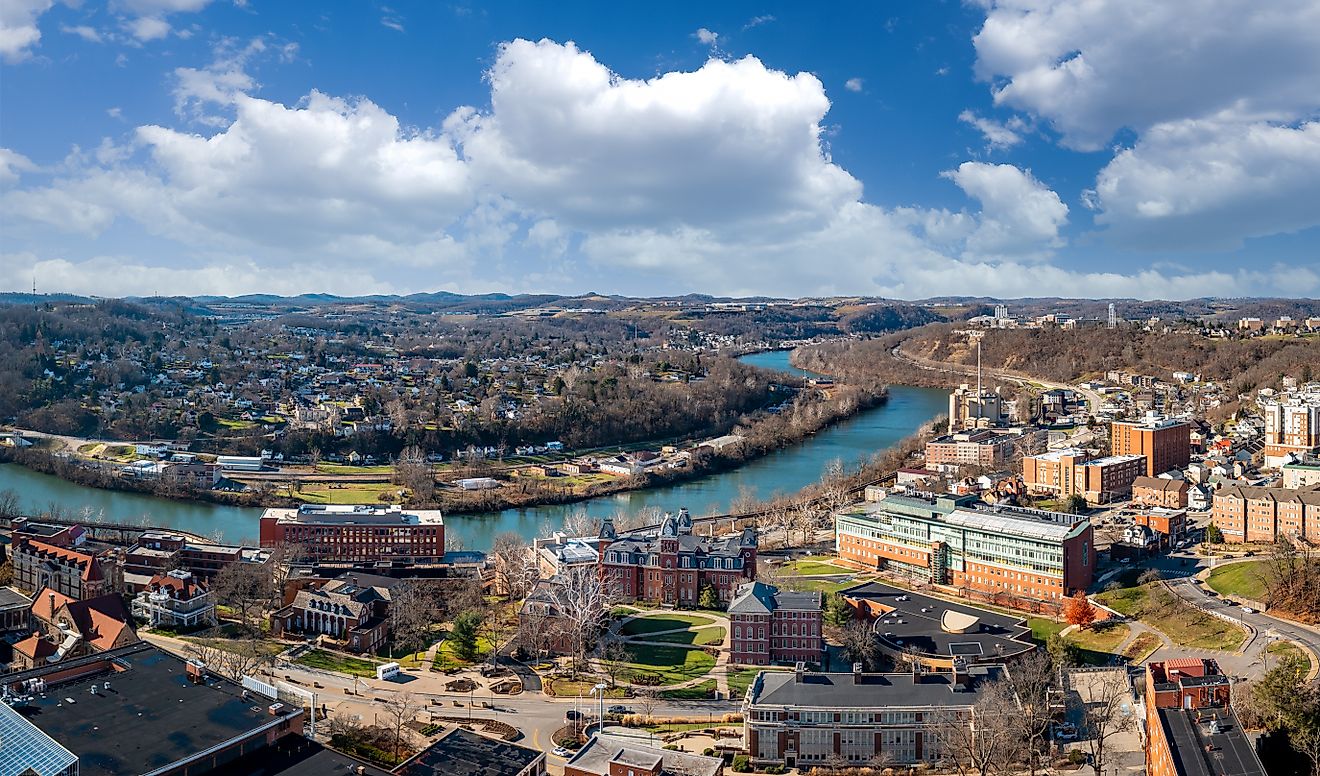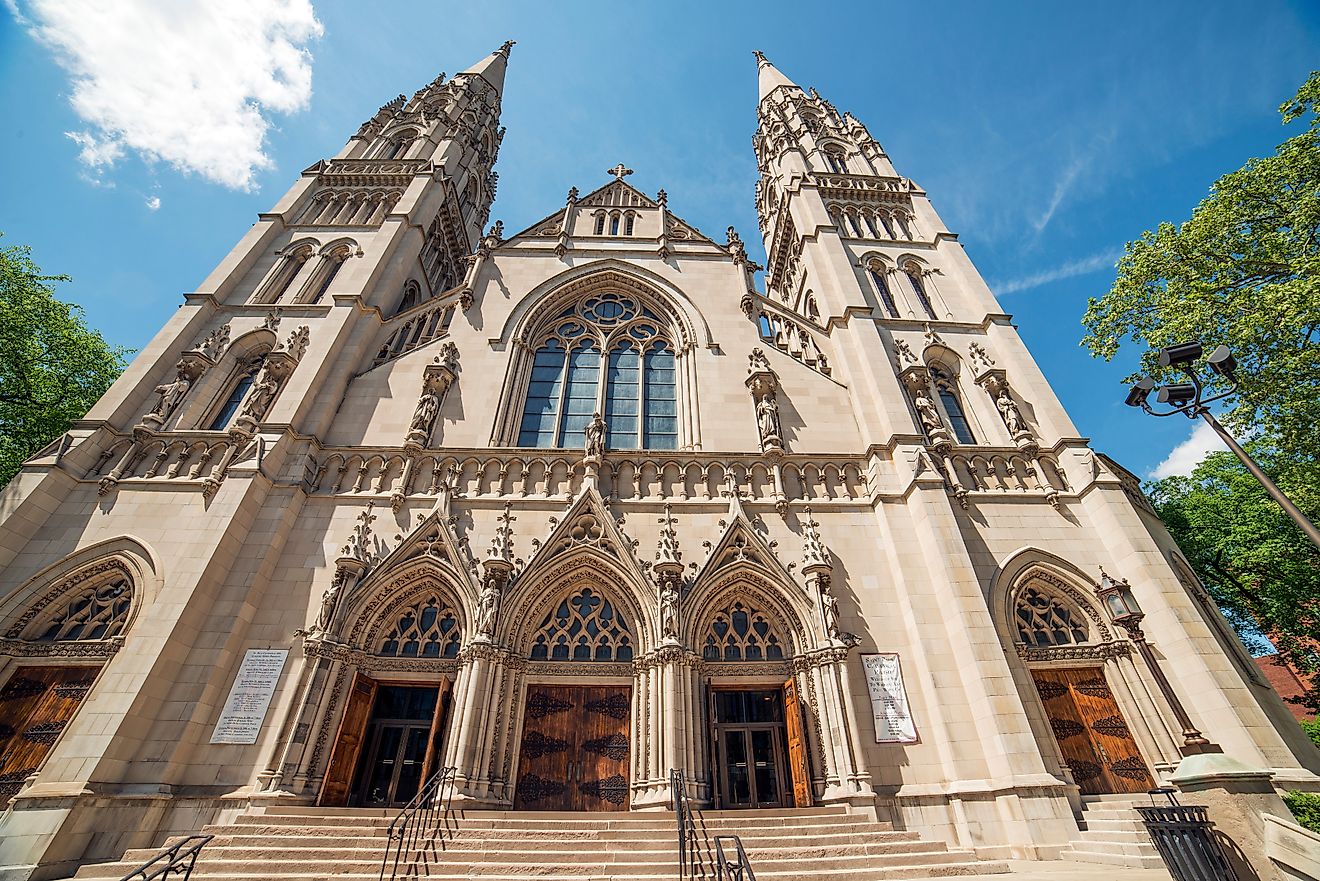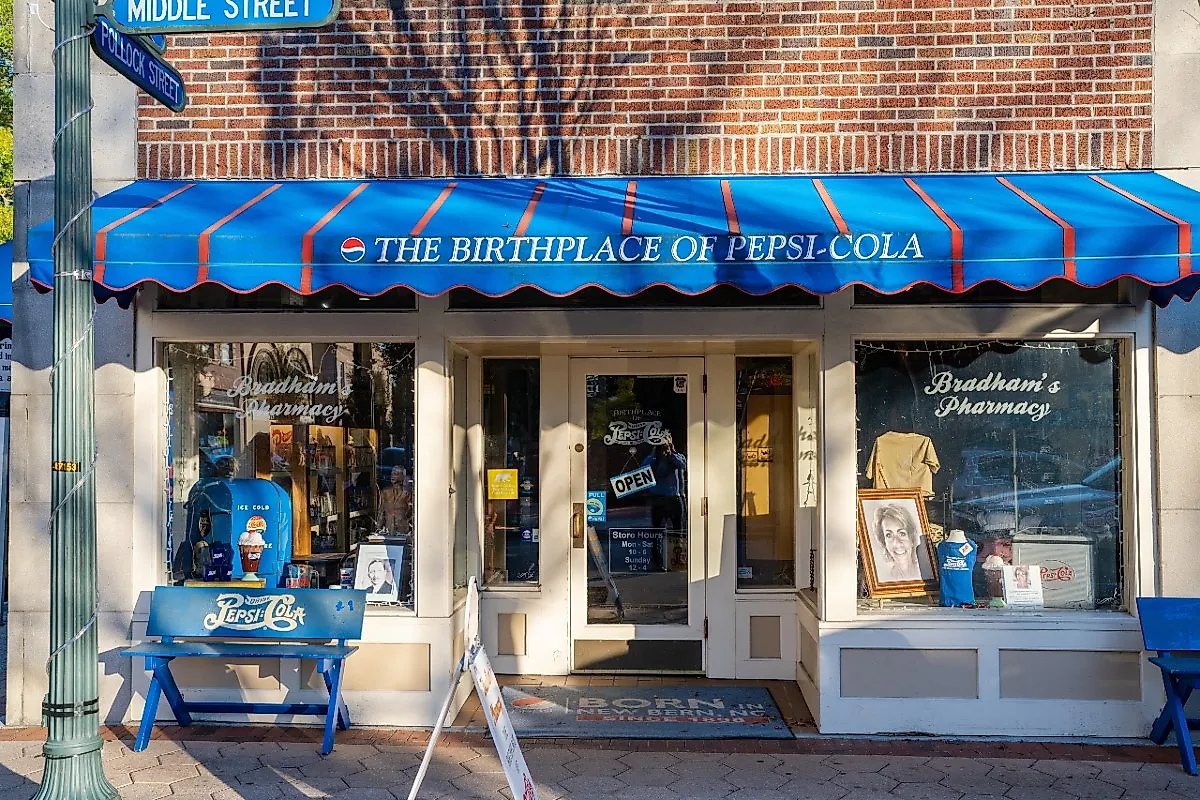
11 Wallet-Friendly Small Towns To Retire In North Carolina
Retirement on a budget doesn’t have to feel like downsizing, it can feel like editing. Trim the sprawl, keep the good stuff: a walkable main street, a clinic close by, a river or greenway for daily laps, and a café that learns your order by week two.
What follows is a cross-section of North Carolina that trades skyline bragging rights for everyday utility. These 11 places aren’t “cheap”, they’re efficient. They buy you time, proximity, and a rhythm you can actually live with.
Elizabeth City
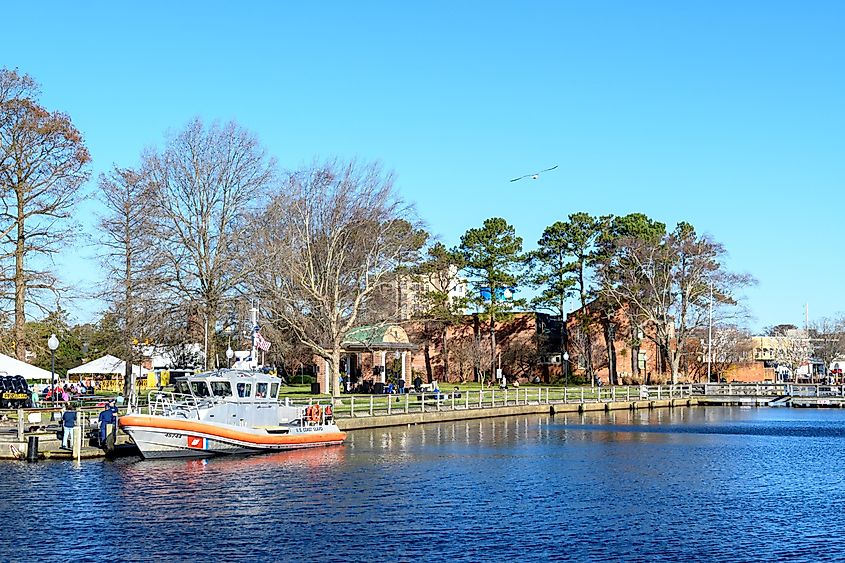
Elizabeth City sits along the Pasquotank River, just inland from the Albemarle Sound, with a rich maritime history that quietly anchors its identity. Known historically as the “Harbor of Hospitality,” the town was once a vital stop for schooners and shipping routes. It still retains that river-town rhythm, with restored waterfront buildings, flatboats moored along the docks, and a walkable downtown full of 19th-century architecture. The city is also home to one of the few remaining zeppelin hangars from WWII, a nod to its unique military past.
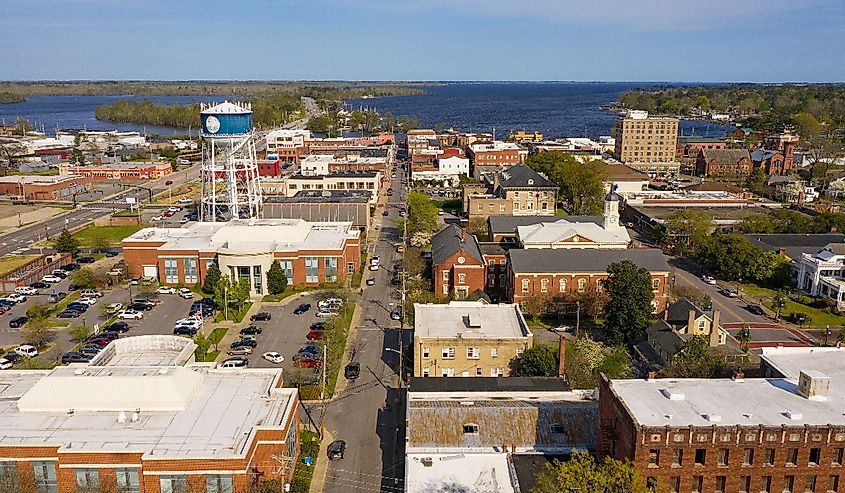
The median home price in Elizabeth City is well below North Carolina’s statewide average, making it one of the most cost-accessible waterfront communities for retirement in the region. Cultural anchors include the Museum of the Albemarle, a compact but curated space with permanent exhibits on northeastern North Carolina’s coastal history. Mariners’ Wharf Park hosts outdoor concerts by the river during warmer months and connects directly to the downtown promenade. Muddy Waters Coffeehouse, set inside a brick-lined historic building, has become a fixture for locals. On the north end of town, Hoppin' Johnz New South Cuisine serves up Southern staples with a coastal twist, shrimp and grits, fried green tomatoes, at prices that align with the town’s affordability.
New Bern
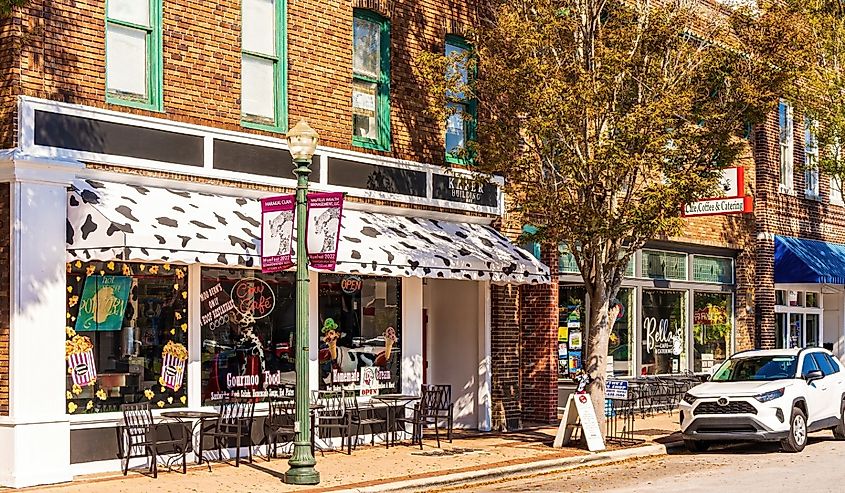
New Bern was North Carolina’s first capital, and its layered past remains visible in its street grid, riverfront, and brick facades. Founded by Swiss settlers in 1710, the town blends colonial layout with riverside openness at the confluence of the Neuse and Trent Rivers. Tryon Palace, a Georgian-style governor’s mansion rebuilt on its original footprint, anchors the town’s historical core. Nearby, the Birthplace of Pepsi museum marks the spot where pharmacist Caleb Bradham invented the soft drink in 1893, inside what is now a narrow storefront with a soda fountain and memorabilia-lined walls.
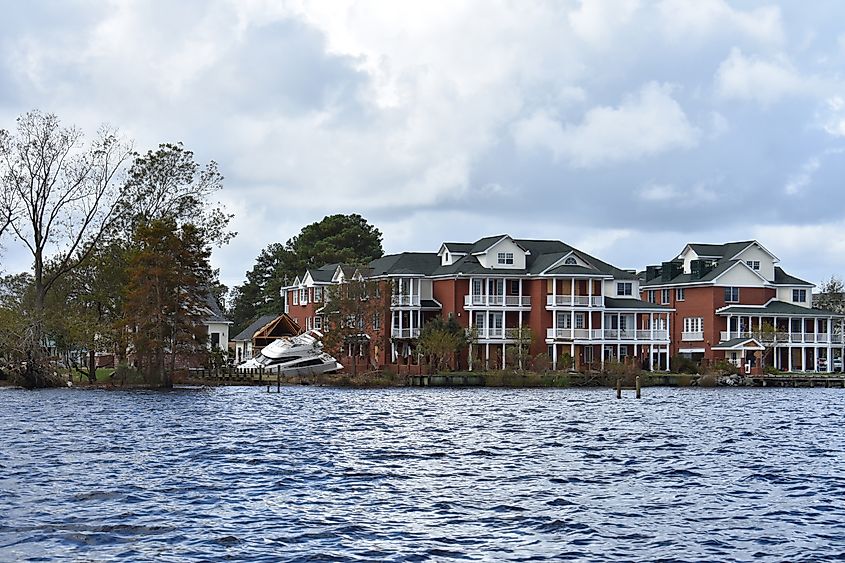
Despite its tourism draw, New Bern’s median home price remains below the North Carolina average, offering a rare combination of affordability and access to waterfront property. Union Point Park, a six-acre peninsula at the meeting of the rivers, includes boat slips, a fishing pier, and shaded paths overlooking moored sailboats. Persimmons Waterfront Restaurant serves seafood beside the dock, often timed with live jazz or bluegrass. The historic district’s grid of walkable streets includes antique shops, small galleries, and restored homes that reflect the town’s 18th- and 19th-century roots.
Salisbury
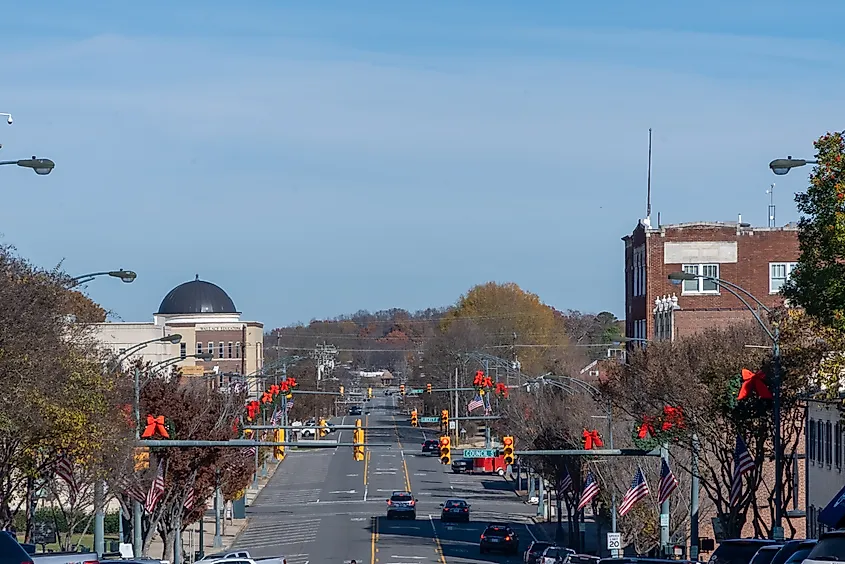
Salisbury has five designated historic districts and one of the oldest continuously operating theaters in the state. Its downtown features late 19th- and early 20th-century buildings that haven’t been gutted or replaced, and the preservation effort here is unusually consistent. The 1855-built Hall House, once home to a local surgeon, anchors a part of West Bank Street where gas lanterns and original brickwork remain intact. Nearby, the Bell Tower Green, a nine-acre park built on a former church lot, functions as both a community hub and concert venue, with shaded lawns and stone walkways that connect directly to downtown shops.
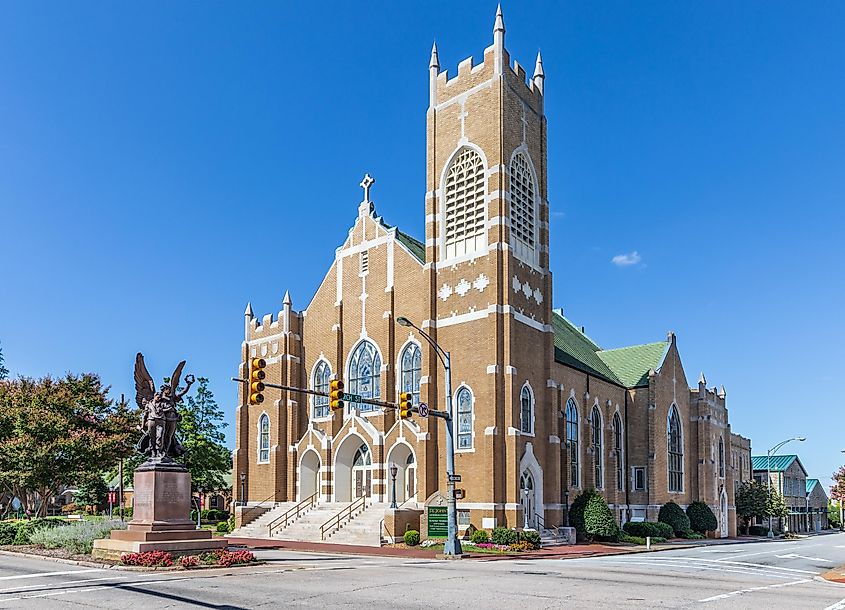
The median home price in Salisbury sits comfortably below North Carolina’s statewide average, with a mix of bungalow, Federal, and early Craftsman homes available within walking distance of the central district. The Rowan Museum, housed in a 19th-century courthouse, offers rotating exhibits on regional rail history and textile production. Koco Java, a local café near Catawba College, roasts in-house and draws a mix of retirees and students. For lunch, Hap's Grill serves hot dogs and burgers out of a window with no indoor seating, just a sidewalk line and a local reputation that spans decades. Salisbury maintains affordability without sacrificing architectural continuity or civic investment.
Lexington
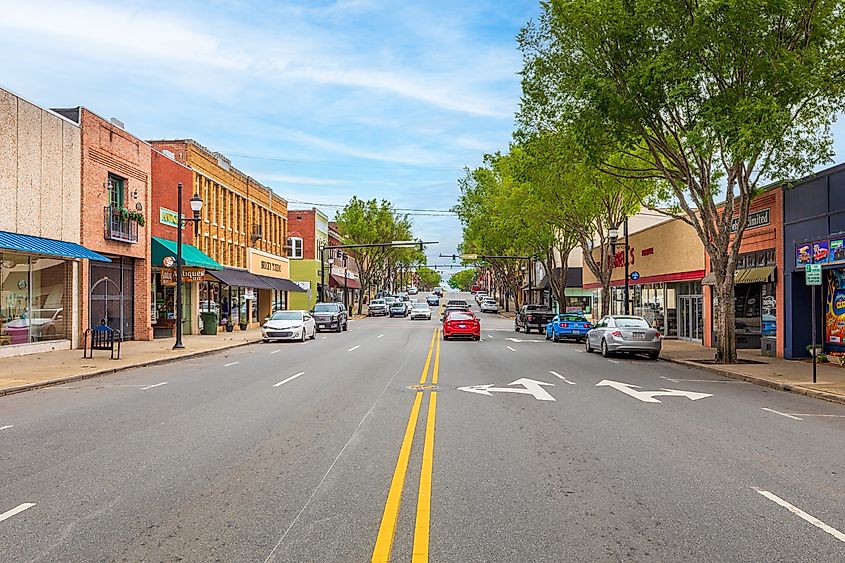
Lexington is known statewide for its vinegar-based barbecue and has more barbecue restaurants per capita than anywhere else in North Carolina. The town also leans into public art, with over 25 pig sculptures scattered across downtown, each painted differently as part of the “Pigs in the City” project. The arts district overlaps with the old railway corridor, where the restored 1912 freight depot now hosts concerts and seasonal markets. The Bob Timberlake Gallery, dedicated to the local realist painter, offers access to decades of his work inside a reclaimed furniture factory with open-beam ceilings and a working fireplace.
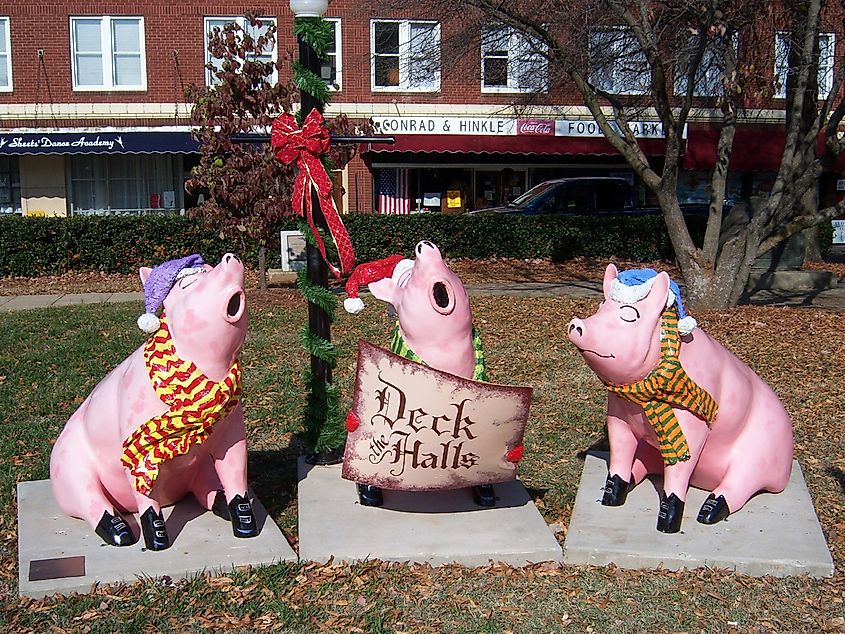
The median home price in Lexington falls well below the state average, with many homes situated within a short drive of the High Rock Lake area or walkable to Main Street. The Davidson County Historical Museum, housed in a Greek Revival courthouse, includes exhibits on Lexington’s furniture-making history and Civil War legacy. The tasting room at Childress Vineyards, just outside town, overlooks acres of rolling vines and hosts weekly wine-pairing events. Downtown, The Bistro at Childress serves lunch daily with regional produce and vineyard pairings.
Asheboro
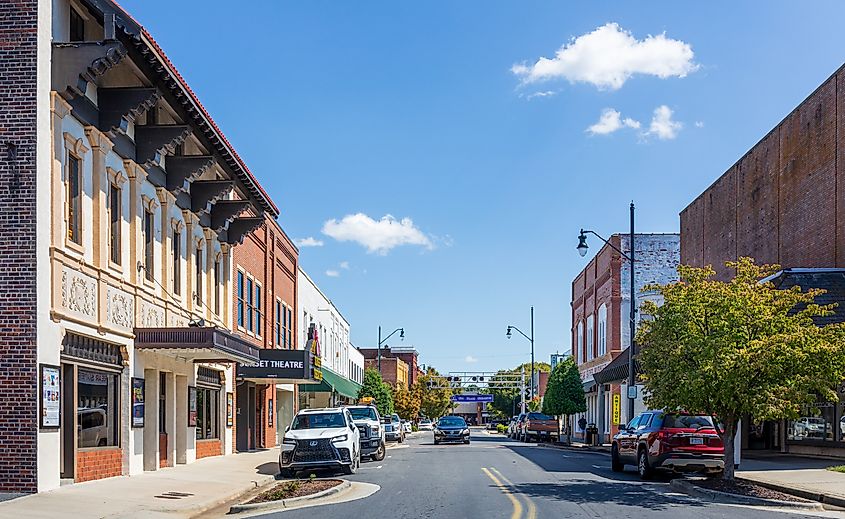
Asheboro is home to the North Carolina Zoo, one of the largest natural habitat zoos in the world, built into the forested hills of the Uwharrie region. The site spans over 2,500 wooded acres and features full-scale African and North American ecosystems with species like elephants, bison, and red wolves. Just south of town, the Pisgah Covered Bridge, one of only two remaining in the state, sits tucked into a wooded ravine and offers access to short hiking loops and seasonal wildflowers. Downtown Asheboro centers around Sunset Avenue, where restored storefronts house working studios, a historic theatre, and community events anchored by Bicentennial Park.
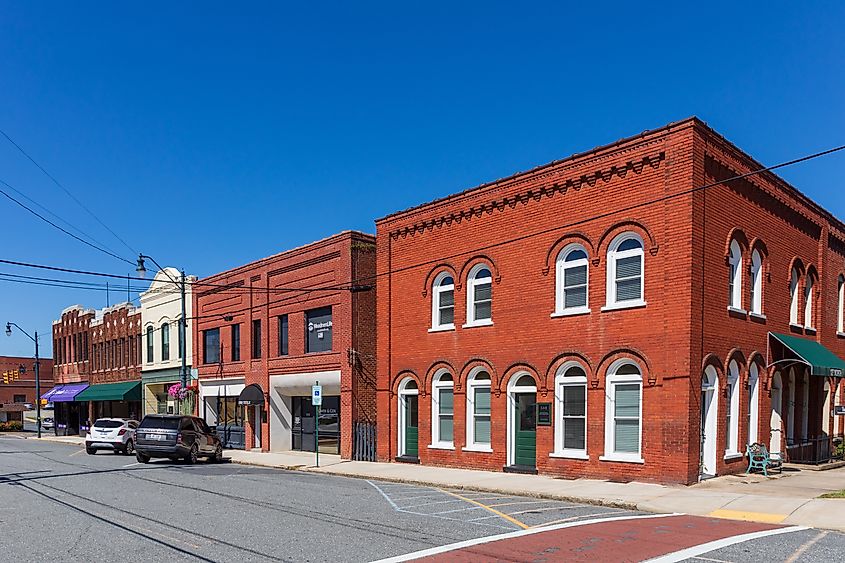
The median home price in Asheboro remains well under the North Carolina state average, with mid-century homes, mill cottages, and modest new builds available throughout the city limits. The Randolph Arts Guild, located inside a repurposed gas station, hosts juried exhibits and regional folk art events year-round. The Table Farmhouse Bakery serves scratch-made breakfast and lunch in a former department store with exposed brick and long communal tables. Brightside Gallery sells antique books and holds live readings on weekends. Nearby, Four Saints Brewing Company occupies a former hardware store and features small-batch taps brewed just feet from the bar.
Morganton
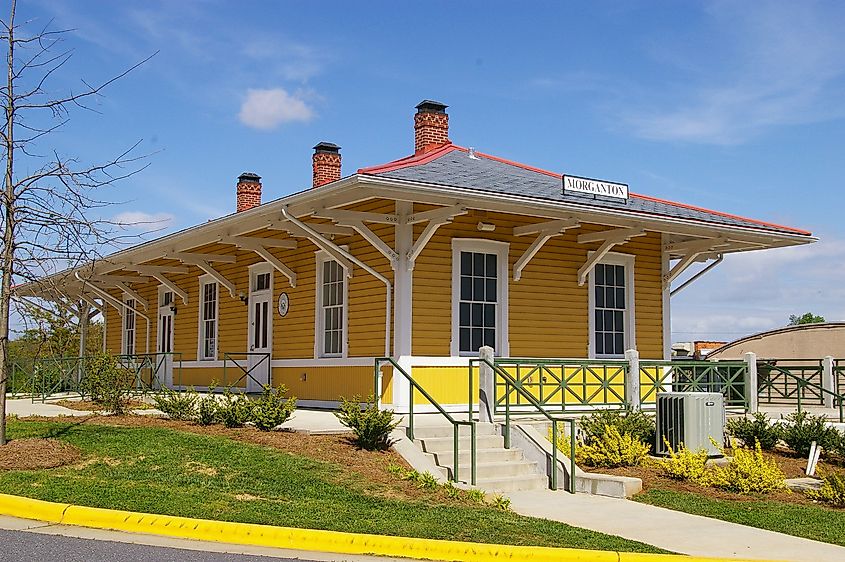
Morganton sits at the base of the Blue Ridge Mountains, with a direct line of sight to Table Rock, a jagged, exposed peak that dominates the horizon and anchors most of the town’s geography. Part of the Catawba Valley wine region, Morganton supports small-batch growers and independent tasting rooms, including Silver Fork Winery, which offers views of the South Mountains from its hillside patio. The Catawba River Greenway runs through town with paved sections for walking and biking, connecting to Freedom Park and a seasonal farmers market near the riverbank. In the center of town, the restored Morganton General Store now houses the Brown Mountain Bottleworks, where rotating North Carolina beers are served alongside live bluegrass on Friday nights.
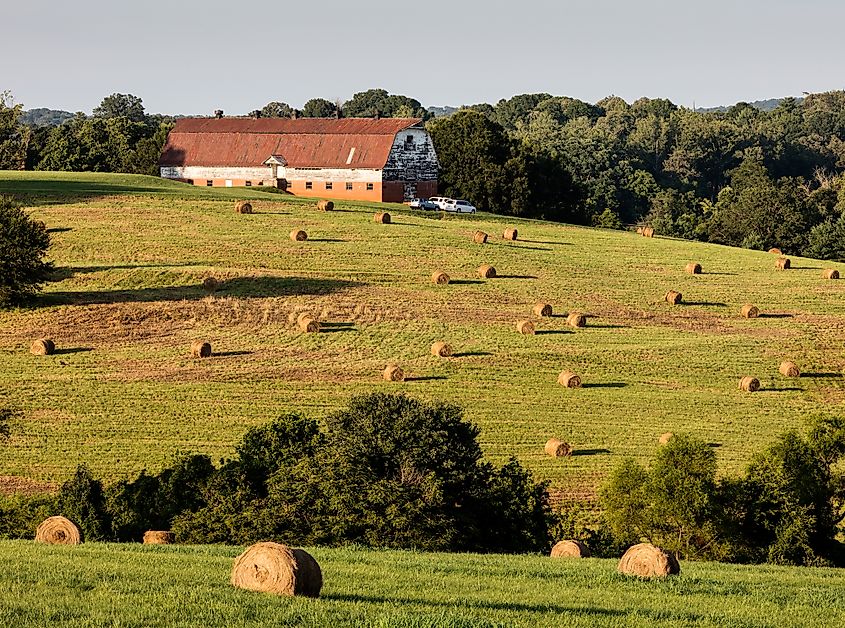
The median home price in Morganton is significantly lower than the statewide average, and neighborhoods near downtown offer single-story homes within blocks of galleries, clinics, and civic buildings. The History Museum of Burke County, located inside a 1928 school building, preserves records of the Waldensian settlers who helped build nearby Valdese. The Grind Café on Union Street serves breakfast and espresso with seating under a tin awning. Root & Vine, located across the street, offers a seasonal lunch menu that includes locally sourced trout and house-cured meats.
Lenoir
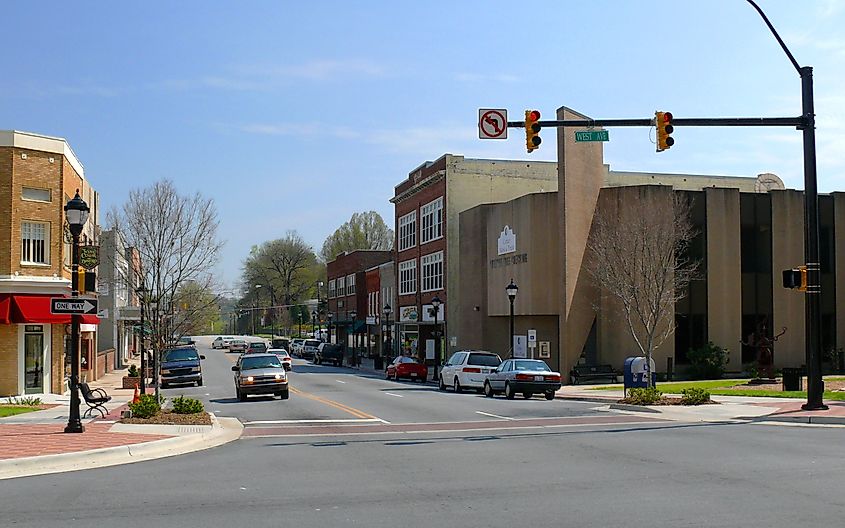
Lenoir is known for its sculpture collection, one of the largest per capita in the U.S., with over 80 public works installed across parks, sidewalks, and municipal buildings. The city’s commitment to sculpture began with local artists in the 1980s and expanded into the Caldwell Arts Council’s permanent outdoor trail. The town also sits at the foothills of the Blue Ridge Mountains, with Wilson Creek, part of a federally designated Wild and Scenic River, just 12 miles west. On Saturday mornings, the Lenoir Downtown Farmers Market sets up along Church Street beside shaded pavilions and brick storefronts. Many of the vendors come from multi-generational farms within the county.
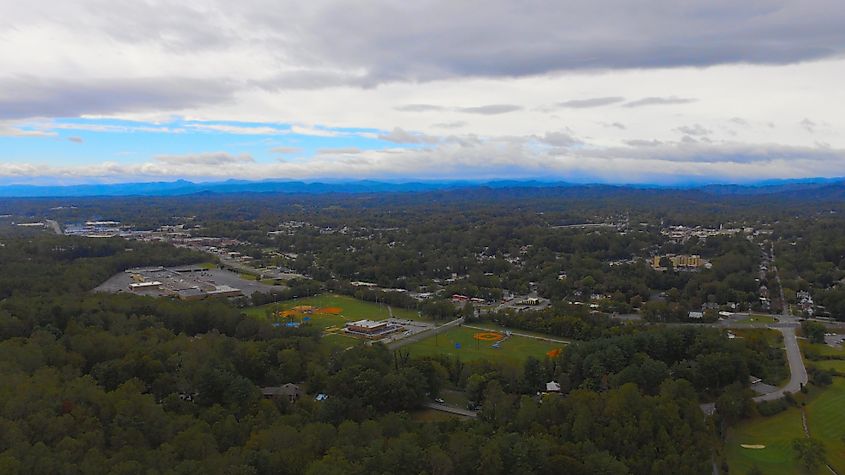
The median home price in Lenoir remains well under the North Carolina average, with bungalows, brick ranches, and infill cottages available within city limits. Downtown, Tybrisa Books operates inside a former five-and-dime store and stocks regional titles and Appalachian histories. Just around the corner, the Side Street Pour House offers 40 beers on tap with a menu built around local beef and regional trout. The J.E. Broyhill Walking Park features paved loops around koi ponds and flowering trees and is maintained year-round by city crews, providing a quiet loop for daily walking within minutes of downtown.
Mount Airy
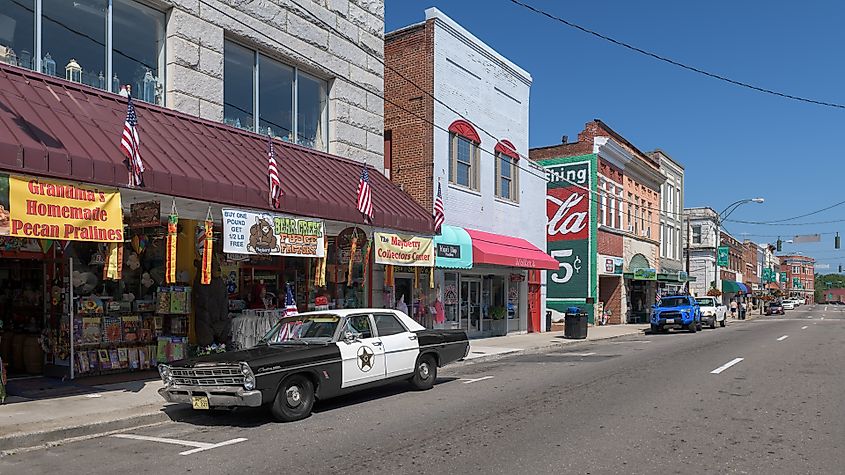
Mount Airy is the birthplace of Andy Griffith and the real-life model for the fictional town of Mayberry. The connection is more than symbolic: the Snappy Lunch diner serves pork chop sandwiches using the same flat-top griddle from the 1960s. Wally’s Service Station operates squad car tours through town in a refurbished 1962 Ford Galaxie. At the northern edge of town, Mount Airy Museum of Regional History houses exhibits on granite quarrying, early medicine, and the Yadkin Valley’s role in Prohibition-era liquor production.
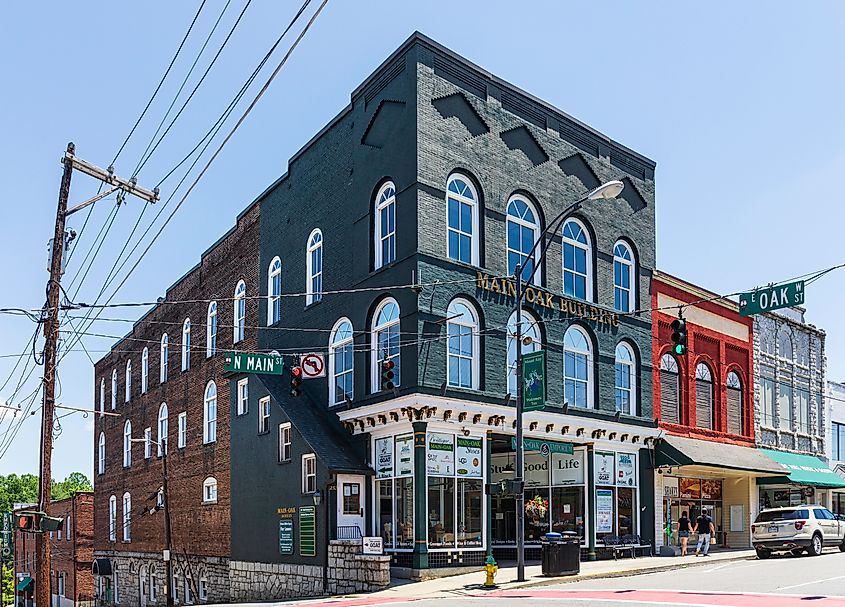
The median home price in Mount Airy remains well below the statewide average, with most single-story homes and mid-century builds situated within walking distance of retail and medical services. The Downtown Cinema Theatre, still in operation since 1939, shows first-run films on a single screen under its original neon marquee. The Surrey County Farmers Market operates on Fridays near the Earle Theatre, where the WPAQ “Merry-Go-Round” radio show broadcasts live bluegrass. For coffee and breakfast, Miss Angels Heavenly Pies serves hand pies, apple cider donuts, and hard cider made on-site from orchard-grown apples in nearby Ararat. Pilot Mountain State Park lies fifteen minutes south and offers day access to trails and overlooks.
Sanford
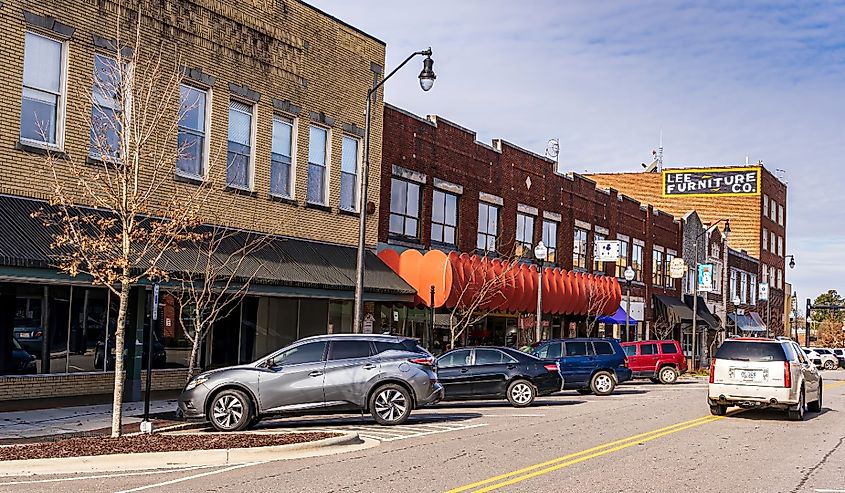
Sanford was once the brickmaking capital of the South, producing clay-fired brick that helped build cities from Atlanta to Washington, D.C. That legacy still marks the landscape, especially in the Downtown Sanford Historic District, where nearly every structure is built from the reddish, sand-textured brick produced in local kilns. Depot Park, located beside the restored railroad depot, acts as a central gathering space for festivals and outdoor concerts, backed by the original passenger platforms and telegraph tower. The Temple Theatre, a former Vaudeville house opened in 1925, continues to stage live productions and regional musicals in its original 299-seat venue.
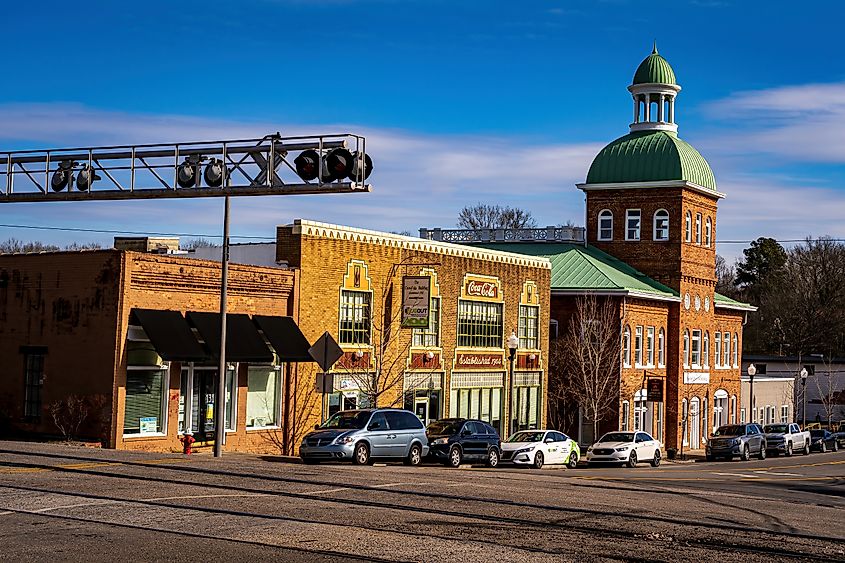
The median home price in Sanford remains below North Carolina’s statewide average, with brick ranches and small-lot new construction available in both city neighborhoods and nearby rural pockets. San-Lee Park, located five minutes east of downtown, includes two lakes, wooded trails, and a nature center with live reptile exhibits. Yarborough’s Homemade Ice Cream on Hawkins Avenue has operated since 1939 and serves small-batch flavors from the same corner location. Hugger Mugger Brewing Company runs its taproom and tanks from a converted warehouse and hosts quiz nights, food trucks, and a monthly storytelling series featuring local writers and musicians from across Lee County.
Washington
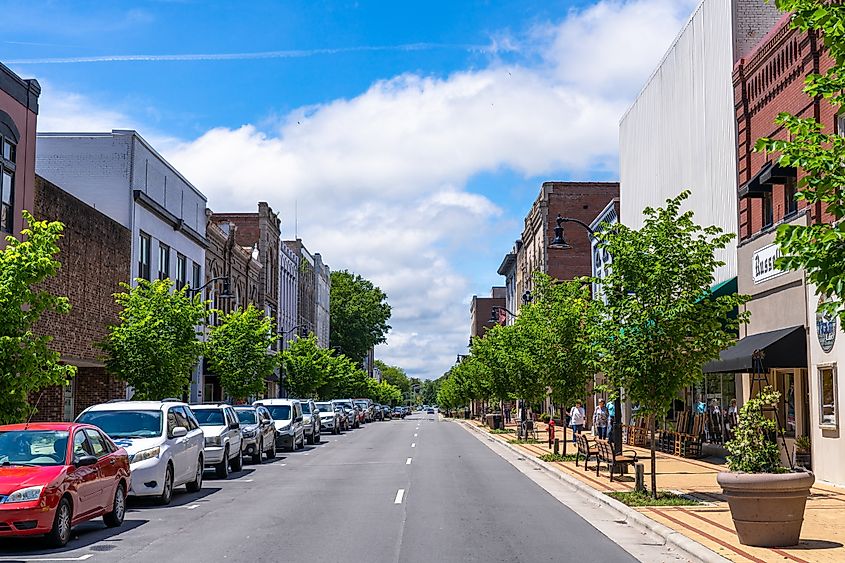
Washington, often called “Little Washington” to distinguish it from the nation’s capital, was the first American town named after George Washington. Located at the junction of the Tar and Pamlico Rivers, the town developed as a deepwater port for coastal trade and privateers during the Revolutionary War. The riverfront remains central, with a long boardwalk running parallel to Stewart Parkway, where sailboats dock within feet of downtown shops. The North Carolina Estuarium sits near the waterfront and combines science exhibits with local maritime artifacts, including a working reproduction of an estuary crab shack.
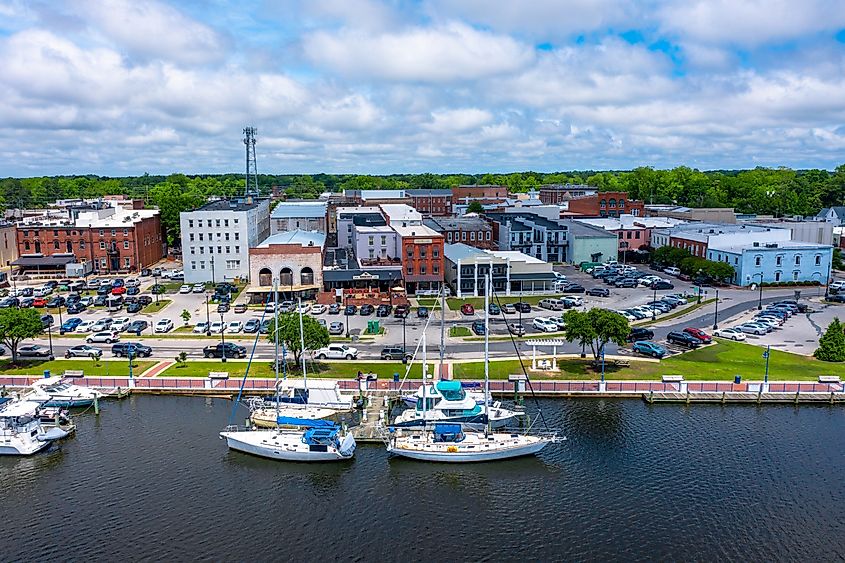
The median home price in Washington remains well below the state average, with small 20th-century homes and craftsman bungalows common within the city grid. Inner Banks Artisans’ Center, located in a converted hardware store, houses studios and galleries for painters, potters, and textile artists. Rachel K’s Bakery operates from a brick corner building near Main Street and offers breakfast plates, lunch sandwiches, and bread baked daily. Down the block, The Hackney distills gin on-site and serves a fixed menu in a renovated bank with the original vault still intact. Festival Park hosts seasonal jazz nights, seafood events, and paddleboard launches with direct access to the Pamlico’s flatwater stretches.
Kinston
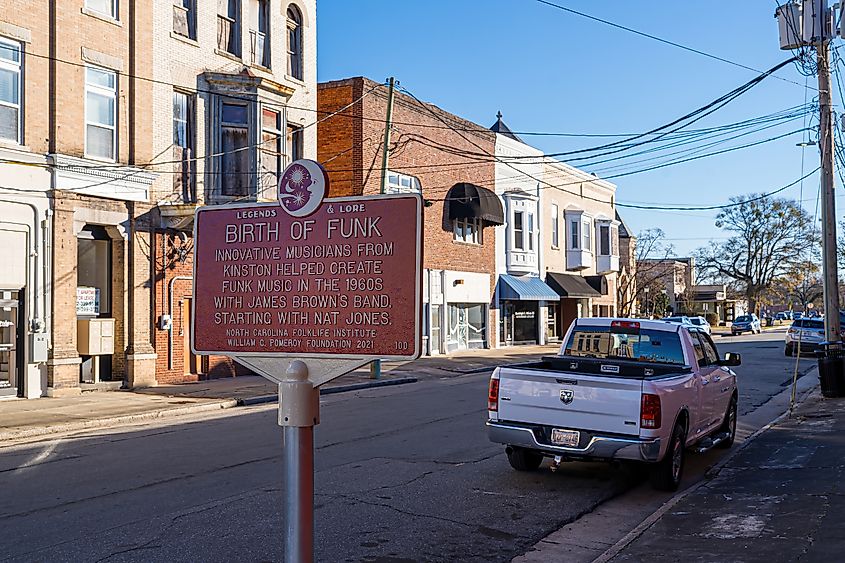
Kinston built its downtown identity on reinvention. Once a textile and tobacco hub, the town now centers around food, art, and a preserved Civil War legacy. The CSS Neuse Civil War Interpretive Center houses the salvaged hull of an ironclad gunboat used by the Confederacy, displayed in a climate-controlled gallery along Queen Street. Nearby, Mother Earth Brewing operates inside a former department store and includes a solar-powered taproom, a rooftop beer garden, and an on-site distillery. Public art is visible throughout the downtown district, with large-scale murals and sculptures funded through the smART Kinston City Project Foundation.
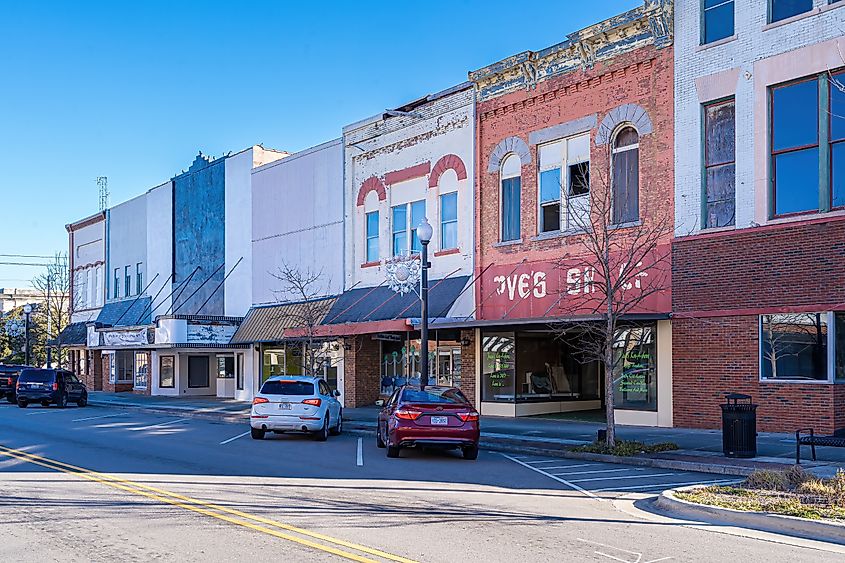
The median home price in Kinston falls well below the North Carolina average, and the city offers mill houses, craftsman homes, and new in-fill construction within blocks of the downtown grid. Vivian Howard’s Chef & the Farmer restaurant helped redefine the local dining scene and still runs limited seatings centered on eastern North Carolina ingredients. Down the block, The O’Neil operates as a cocktail bar inside a converted 1920s bank lobby. Lions Water Adventure offers outdoor lap lanes and river-style pools beside the community center. Herritage Landing, along the Neuse River, provides open-air access for kayaking, shoreline fishing, and the town’s annual BBQ Festival on the Neuse.
These towns prove affordability isn’t compromise; it’s design. Each clears the Porch-to-Pier test and delivers the essentials, care, culture, greenways, and groceries, within a short radius. With populations under 50,000 and median home prices under the state line, the math stays steady even as amenities stack up. Choose riverfront boardwalks, sculpture walks, zoo trails, or barbecue corridors; every option buys back time, trims hassle, and preserves rituals that make retirement sustainable long-term.
